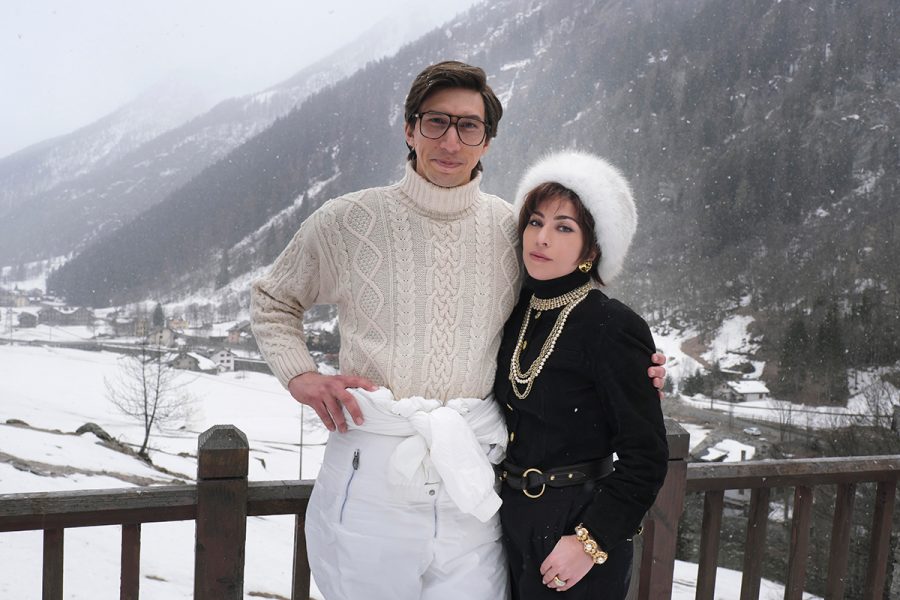Ridley Scott’s ‘House of Gucci’ dramatizes the scandalous true story
December 13, 2021
Editor’s Note: The character of Patrizia Reggiani in the movie will be referred to by her first name while the actual person of the same name will be referred to by her last name.
“Father, son and House of Gucci,” has been the motto of many movie-goers since Nov. 24, when Ridley Scott’s “House of Gucci” was released.
Inspired by the true story, the film follows Patrizia Reggiani, played by Lady Gaga, who tries to find her place in the family business after marrying Maurizio Gucci, played by Adam Driver. In doing so, things go south for both the Gucci family and her marriage.
“House of Gucci” brings its viewers back to the era of the 1970s and into the ‘90s, before Patrizia, also known as “Lady Gucci” or the “Black Widow” of fashion, hired a hitman to have her husband murdered. However, the story’s basis in reality leaves little to surprise, which encourages the writers to get creative in their approach to the complex story.
The slow-burn film focuses on the events that lead to Patrizia’s decision, including the part the family business played in it.
On one hand, the film is scandalous in telling the tale of Patrizia and Maurizio’s marriage, from her being denied a welcome into the Gucci family by Maurizio’s father, Rodolfo, played by Jeremy Irons, to the inevitable murder plan designed alongside her psychic advisor, Pina Auriemma, played by Salma Hayek.
On the other hand, viewers get a look inside the Gucci family legacy and all the backstabbing that surrounded it, with some help from characters, Aldo, played by Al Pacino, and Paolo Gucci, portrayed by Jared Leto.
The movie isn’t exactly the shortest at two hours and 38 minutes and is not as fast paced as a standard Hollywood film. Nevertheless, no part is unnecessary, and everything adds up to one of the most compelling movies this year. The writers manage to pull off the multiple-part story that could’ve easily gotten lost behind the glamour and come off as a hodgepodge of disconnected storylines.
All eyes have been on the star-studded cast as critics compare each actor’s performance to the person they embodied, especially Gaga. She revealed that she used method acting to give the best version of Patrizia she could, which included speaking in an Italian accent on and off the set for about a year.
In spite of this, Gaga received much backlash over her portrayal, as many critical linguists deemed the accent Russian more than Italian.
Regardless, it is perfect for the movie’s over-the-top nature and when put side-by-side with the real Reggiani in her interviews from the ‘90s, it is clear to see that Gaga was trying to emulate the person behind her character more so than a typical Italian.
The person least thrilled about Gaga’s involvement with the film is Reggiani herself, who expressed in a statement her annoyance over Gaga not meeting her as a part of preparation for the role. In response, Gaga told British Vogue that this choice was rooted in her wanting to pursue the role in a “journalistic” way, stating, “Nobody was going to tell me who Patrizia Gucci was, not even Patrizia Gucci.”
In the end, both the acting and research methods helped the songstress deliver another Oscar- worthy performance, following her 2018 Oscar-nominated role in “A Star Is Born.” Lady Gucci is depicted as a cunning yet human character, in true Gaga style.
Leto’s performance of Paolo also raised eyebrows but for reasons opposite from Gaga. Many viewers felt the portrayal was mocking Italians, in a “Mario and Luigi sort-of way.” In fact, even designer Tom Ford, played by Reeve Carney, who was a close friend of Paolo’s, spoke out against Leto’s performance, calling it campy and unrealistic.
Yet, Leto’s character helped move the story along as both a comedic relief and a portrayal of the family’s dysfunction behind closed doors, though the performance itself lacked dimension. The moments that contain Paolo are the most captivating, even if the threat of Leto doing the stereotypical Italian hand gesture, including the memorable scene in which he urinates on a Gucci scarf as rebellion, seems ever-present.
Driver is bound to deliver a flawless performance, and his portrayal of Maurizio, the kind- hearted heir to the Gucci empire, is nothing short of that. The most talked-about moment in the film is Maurizio and Patrizia’s sex scene, which has nothing sexual and seems to be designed to make the audience uncomfortable. Ultimately, the goal is achieved as the two characters’ personalities are perfectly encapsulated through the actors’ performances in the odd scene.
Another factor that helps move along the film is the fashion, starting with period-specific dresses worn by Reggiani. The wedding dress in the movie wasn’t based on the actual dress Reggiani wore in 1972 when she married into the Gucci family but shows exactly what an Italian bride would wear at the time. Later in the film, Patrizia is dressed in Gucci suits and archives that lets viewers, especially those with knowledge of fashion, know exactly when in the story’s timeline the scene takes place.
From the first line of the film, “It was a name so seductive,” to the last, “You can call me Mrs. Gucci,” which are both voiced by Gaga’s character, “House of Gucci” makes its audience understand the characters emotionally and why they did the things they did, no matter how terrible they were. The alluring and tragic story is dramatized, mixing “The Godfather” with “The Devil Wears Prada,” to create a true crime film near perfection.







